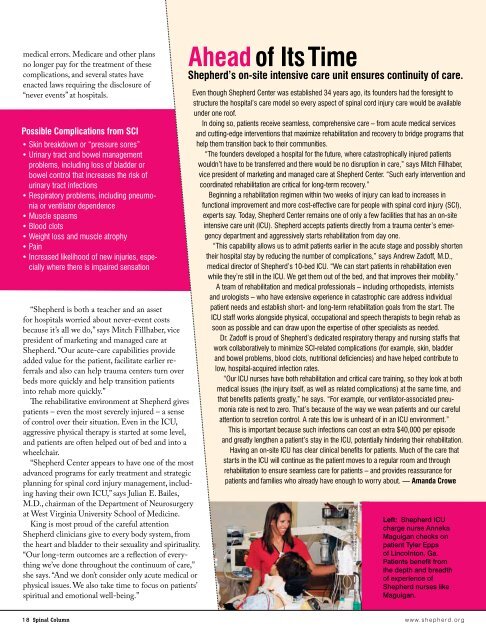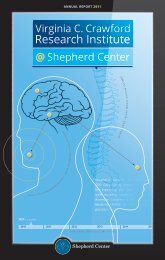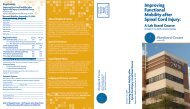the BRAIN - Shepherd Center
the BRAIN - Shepherd Center
the BRAIN - Shepherd Center
You also want an ePaper? Increase the reach of your titles
YUMPU automatically turns print PDFs into web optimized ePapers that Google loves.
medical errors. Medicare and o<strong>the</strong>r plans<br />
no longer pay for <strong>the</strong> treatment of <strong>the</strong>se<br />
complications, and several states have<br />
enacted laws requiring <strong>the</strong> disclosure of<br />
“never events” at hospitals.<br />
Possible Complications from SCI<br />
• Skin breakdown or “pressure sores”<br />
• Urinary tract and bowel management<br />
problems, including loss of bladder or<br />
bowel control that increases <strong>the</strong> risk of<br />
urinary tract infections<br />
• Respiratory problems, including pneumonia<br />
or ventilator dependence<br />
• Muscle spasms<br />
• Blood clots<br />
• Weight loss and muscle atrophy<br />
• Pain<br />
• Increased likelihood of new injuries, especially<br />
where <strong>the</strong>re is impaired sensation<br />
“<strong>Shepherd</strong> is both a teacher and an asset<br />
for hospitals worried about never-event costs<br />
because it’s all we do,” says Mitch Fillhaber, vice<br />
president of marketing and managed care at<br />
<strong>Shepherd</strong>. “Our acute-care capabilities provide<br />
added value for <strong>the</strong> patient, facilitate earlier referrals<br />
and also can help trauma centers turn over<br />
beds more quickly and help transition patients<br />
into rehab more quickly.”<br />
The rehabilitative environment at <strong>Shepherd</strong> gives<br />
patients – even <strong>the</strong> most severely injured – a sense<br />
of control over <strong>the</strong>ir situation. Even in <strong>the</strong> ICU,<br />
aggressive physical <strong>the</strong>rapy is started at some level,<br />
and patients are often helped out of bed and into a<br />
wheelchair.<br />
“<strong>Shepherd</strong> <strong>Center</strong> appears to have one of <strong>the</strong> most<br />
advanced programs for early treatment and strategic<br />
planning for spinal cord injury management, including<br />
having <strong>the</strong>ir own ICU,” says Julian E. Bailes,<br />
M.D., chairman of <strong>the</strong> Department of Neurosurgery<br />
at West Virginia University School of Medicine.<br />
King is most proud of <strong>the</strong> careful attention<br />
<strong>Shepherd</strong> clinicians give to every body system, from<br />
<strong>the</strong> heart and bladder to <strong>the</strong>ir sexuality and spirituality.<br />
“Our long-term outcomes are a reflection of everything<br />
we’ve done throughout <strong>the</strong> continuum of care,”<br />
she says. “And we don’t consider only acute medical or<br />
physical issues. We also take time to focus on patients’<br />
spiritual and emotional well-being.”<br />
Ahead of Its Time<br />
<strong>Shepherd</strong>’s on-site intensive care unit ensures continuity of care.<br />
Even though <strong>Shepherd</strong> <strong>Center</strong> was established 34 years ago, its founders had <strong>the</strong> foresight to<br />
structure <strong>the</strong> hospital’s care model so every aspect of spinal cord injury care would be available<br />
under one roof.<br />
In doing so, patients receive seamless, comprehensive care – from acute medical services<br />
and cutting-edge interventions that maximize rehabilitation and recovery to bridge programs that<br />
help <strong>the</strong>m transition back to <strong>the</strong>ir communities.<br />
“The founders developed a hospital for <strong>the</strong> future, where catastrophically injured patients<br />
wouldn’t have to be transferred and <strong>the</strong>re would be no disruption in care,” says Mitch Fillhaber,<br />
vice president of marketing and managed care at <strong>Shepherd</strong> <strong>Center</strong>. “Such early intervention and<br />
coordinated rehabilitation are critical for long-term recovery.”<br />
Beginning a rehabilitation regimen within two weeks of injury can lead to increases in<br />
functional improvement and more cost-effective care for people with spinal cord injury (SCI),<br />
experts say. Today, <strong>Shepherd</strong> <strong>Center</strong> remains one of only a few facilities that has an on-site<br />
intensive care unit (ICU). <strong>Shepherd</strong> accepts patients directly from a trauma center’s emergency<br />
department and aggressively starts rehabilitation from day one.<br />
“This capability allows us to admit patients earlier in <strong>the</strong> acute stage and possibly shorten<br />
<strong>the</strong>ir hospital stay by reducing <strong>the</strong> number of complications,” says Andrew Zadoff, M.D.,<br />
medical director of <strong>Shepherd</strong>’s 10-bed ICU. “We can start patients in rehabilitation even<br />
while <strong>the</strong>y’re still in <strong>the</strong> ICU. We get <strong>the</strong>m out of <strong>the</strong> bed, and that improves <strong>the</strong>ir mobility.”<br />
A team of rehabilitation and medical professionals – including orthopedists, internists<br />
and urologists – who have extensive experience in catastrophic care address individual<br />
patient needs and establish short- and long-term rehabilitation goals from <strong>the</strong> start. The<br />
ICU staff works alongside physical, occupational and speech <strong>the</strong>rapists to begin rehab as<br />
soon as possible and can draw upon <strong>the</strong> expertise of o<strong>the</strong>r specialists as needed.<br />
Dr. Zadoff is proud of <strong>Shepherd</strong>’s dedicated respiratory <strong>the</strong>rapy and nursing staffs that<br />
work collaboratively to minimize SCI-related complications (for example, skin, bladder<br />
and bowel problems, blood clots, nutritional deficiencies) and have helped contribute to<br />
low, hospital-acquired infection rates.<br />
“Our ICU nurses have both rehabilitation and critical care training, so <strong>the</strong>y look at both<br />
medical issues (<strong>the</strong> injury itself, as well as related complications) at <strong>the</strong> same time, and<br />
that benefits patients greatly,” he says. “For example, our ventilator-associated pneumonia<br />
rate is next to zero. That’s because of <strong>the</strong> way we wean patients and our careful<br />
attention to secretion control. A rate this low is unheard of in an ICU environment.”<br />
This is important because such infections can cost an extra $40,000 per episode<br />
and greatly leng<strong>the</strong>n a patient’s stay in <strong>the</strong> ICU, potentially hindering <strong>the</strong>ir rehabilitation.<br />
Having an on-site ICU has clear clinical benefits for patients. Much of <strong>the</strong> care that<br />
starts in <strong>the</strong> ICU will continue as <strong>the</strong> patient moves to a regular room and through<br />
rehabilitation to ensure seamless care for patients – and provides reassurance for<br />
patients and families who already have enough to worry about. — Amanda Crowe<br />
Photo by Gary Meek<br />
Left: <strong>Shepherd</strong> ICU<br />
charge nurse Anneka<br />
Maguigan checks on<br />
patient Tyler Epps<br />
of Lincolnton, Ga.<br />
Patients benefit from<br />
<strong>the</strong> depth and breadth<br />
of experience of<br />
<strong>Shepherd</strong> nurses like<br />
Maguigan.<br />
1 8 Spinal Column<br />
w w w. s h e p h e r d . o r g

















